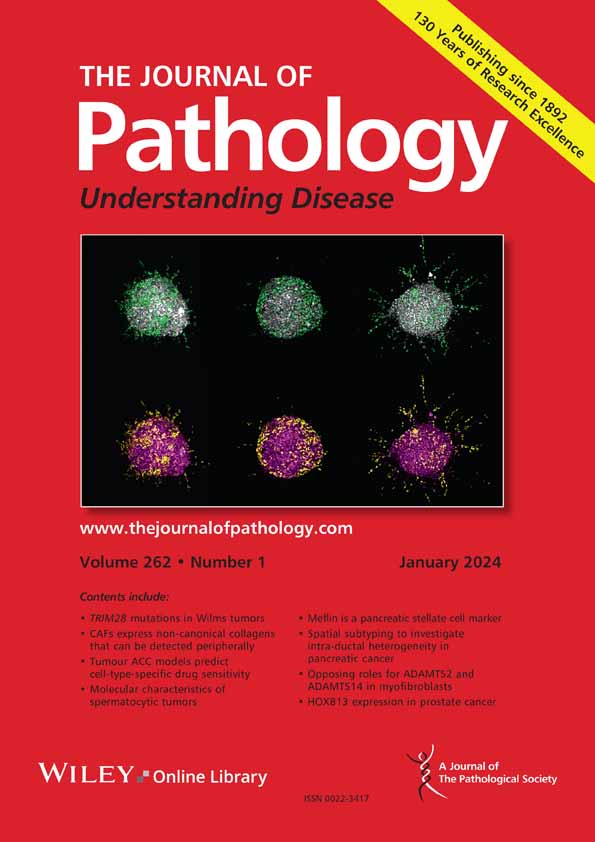Human colonic organoids for understanding early events of familial adenomatous polyposis pathogenesis
IF 5.2
2区 医学
Q1 ONCOLOGY
Nolwenn Laborde, Alexandre Barusseaud, Muriel Quaranta, Corinne Rolland, Amélie Arrouy, Delphine Bonnet, Sylvain Kirzin, Nuria Sola-Tapias, Dimitri Hamel, Karl Barange, Jean-Pierre Duffas, Marie-Pierre Gratacap, Julie Guillermet-Guibert, Anne Breton, Nathalie Vergnolle, Laurent Alric, Audrey Ferrand, Frédérick Barreau, Claire Racaud-Sultan, Emmanuel Mas
下载PDF
{"title":"Human colonic organoids for understanding early events of familial adenomatous polyposis pathogenesis","authors":"Nolwenn Laborde, Alexandre Barusseaud, Muriel Quaranta, Corinne Rolland, Amélie Arrouy, Delphine Bonnet, Sylvain Kirzin, Nuria Sola-Tapias, Dimitri Hamel, Karl Barange, Jean-Pierre Duffas, Marie-Pierre Gratacap, Julie Guillermet-Guibert, Anne Breton, Nathalie Vergnolle, Laurent Alric, Audrey Ferrand, Frédérick Barreau, Claire Racaud-Sultan, Emmanuel Mas","doi":"10.1002/path.6366","DOIUrl":null,"url":null,"abstract":"<p>Patients with familial adenomatous polyposis (FAP) harbor mutations in the <i>APC</i> gene and will develop adenoma and early colorectal cancer. There is no validated treatment, and animal models are not sufficient to study FAP. Our aim was to investigate the early events associated with FAP using the intestinal organoid model in a single-center study using biopsies from nonadenomatous and adenomatous colonic mucosa of FAP patients and from healthy controls (HCs). We analyzed intestinal stem cell (ISC) activity and regulation through organoid development and expression of mRNA and proteins, as well as within colonic crypts. We used several compounds to regulate the signaling pathways controlling ISCs, such as WNT, EGFR, PI3K-AKT, TGF-β, yes-associated protein (YAP), and protease-activated receptors. In addition to their high proliferative capacity, nonadenomatous and adenomatous organoids were characterized by cysts and cysts with buds, respectively, suggesting abnormal maturation. Adenomatous organoids were enriched in the stem cell marker LGR5 and dependent on EGF and TGF-β for their growth. Downstream of EGFR, AKT, β-catenin, and YAP were found to be activated in the adenomatous organoids. While the p110β isoform of PI3K was predominant in adenomatous organoids and essential for their growth, p110α was associated with the immature state of nonadenomatous organoids. We conclude that organoids offer a relevant model for studying FAP, and this work highlights abnormal behaviors of immature cells in both nonadenomatous and adenomatous mucosa of FAP patients, which could be targeted therapeutically. © 2024 The Author(s). <i>The Journal of Pathology</i> published by John Wiley & Sons Ltd on behalf of The Pathological Society of Great Britain and Ireland.</p>","PeriodicalId":232,"journal":{"name":"The Journal of Pathology","volume":"265 1","pages":"26-40"},"PeriodicalIF":5.2000,"publicationDate":"2024-12-06","publicationTypes":"Journal Article","fieldsOfStudy":null,"isOpenAccess":false,"openAccessPdf":"https://www.ncbi.nlm.nih.gov/pmc/articles/PMC11638664/pdf/","citationCount":"0","resultStr":null,"platform":"Semanticscholar","paperid":null,"PeriodicalName":"The Journal of Pathology","FirstCategoryId":"3","ListUrlMain":"https://onlinelibrary.wiley.com/doi/10.1002/path.6366","RegionNum":2,"RegionCategory":"医学","ArticlePicture":[],"TitleCN":null,"AbstractTextCN":null,"PMCID":null,"EPubDate":"","PubModel":"","JCR":"Q1","JCRName":"ONCOLOGY","Score":null,"Total":0}
引用次数: 0
引用
批量引用
Abstract
Patients with familial adenomatous polyposis (FAP) harbor mutations in the APC gene and will develop adenoma and early colorectal cancer. There is no validated treatment, and animal models are not sufficient to study FAP. Our aim was to investigate the early events associated with FAP using the intestinal organoid model in a single-center study using biopsies from nonadenomatous and adenomatous colonic mucosa of FAP patients and from healthy controls (HCs). We analyzed intestinal stem cell (ISC) activity and regulation through organoid development and expression of mRNA and proteins, as well as within colonic crypts. We used several compounds to regulate the signaling pathways controlling ISCs, such as WNT, EGFR, PI3K-AKT, TGF-β, yes-associated protein (YAP), and protease-activated receptors. In addition to their high proliferative capacity, nonadenomatous and adenomatous organoids were characterized by cysts and cysts with buds, respectively, suggesting abnormal maturation. Adenomatous organoids were enriched in the stem cell marker LGR5 and dependent on EGF and TGF-β for their growth. Downstream of EGFR, AKT, β-catenin, and YAP were found to be activated in the adenomatous organoids. While the p110β isoform of PI3K was predominant in adenomatous organoids and essential for their growth, p110α was associated with the immature state of nonadenomatous organoids. We conclude that organoids offer a relevant model for studying FAP, and this work highlights abnormal behaviors of immature cells in both nonadenomatous and adenomatous mucosa of FAP patients, which could be targeted therapeutically. © 2024 The Author(s). The Journal of Pathology published by John Wiley & Sons Ltd on behalf of The Pathological Society of Great Britain and Ireland.
人类结肠类器官用于了解家族性腺瘤性息肉病发病机制的早期事件。
家族性腺瘤性息肉病(FAP)患者携带APC基因突变,将发展为腺瘤和早期结直肠癌。目前尚无有效的治疗方法,动物模型也不足以研究FAP。我们的目的是在单中心研究中使用肠道类器官模型,对FAP患者和健康对照(hc)的非腺瘤性和腺瘤性结肠粘膜进行活检,研究FAP相关的早期事件。我们分析了肠道干细胞(ISC)通过类器官发育、mRNA和蛋白表达以及结肠隐窝的活性和调控。我们使用了几种化合物来调节控制ISCs的信号通路,如WNT、EGFR、PI3K-AKT、TGF-β、yesassociated protein (YAP)和蛋白酶激活受体。除了高增殖能力外,非腺瘤性和腺瘤性类器官分别以囊肿和带芽的囊肿为特征,提示异常成熟。腺瘤样器官富含干细胞标志物LGR5,其生长依赖于EGF和TGF-β。EGFR下游AKT、β-catenin和YAP在腺瘤样器官中被激活。PI3K的p110β亚型在腺瘤性类器官中占主导地位,对它们的生长至关重要,而p110α与非腺瘤性类器官的未成熟状态有关。我们认为,类器官为研究FAP提供了一个相关的模型,这项工作强调了FAP患者非腺瘤和腺瘤粘膜中未成熟细胞的异常行为,可以靶向治疗。©2024作者。《病理学杂志》由John Wiley & Sons Ltd代表大不列颠和爱尔兰病理学会出版。
本文章由计算机程序翻译,如有差异,请以英文原文为准。
来源期刊
期刊介绍:
The Journal of Pathology aims to serve as a translational bridge between basic biomedical science and clinical medicine with particular emphasis on, but not restricted to, tissue based studies. The main interests of the Journal lie in publishing studies that further our understanding the pathophysiological and pathogenetic mechanisms of human disease.
The Journal of Pathology welcomes investigative studies on human tissues, in vitro and in vivo experimental studies, and investigations based on animal models with a clear relevance to human disease, including transgenic systems.
As well as original research papers, the Journal seeks to provide rapid publication in a variety of other formats, including editorials, review articles, commentaries and perspectives and other features, both contributed and solicited.



 求助内容:
求助内容: 应助结果提醒方式:
应助结果提醒方式:


